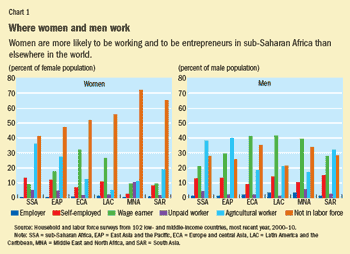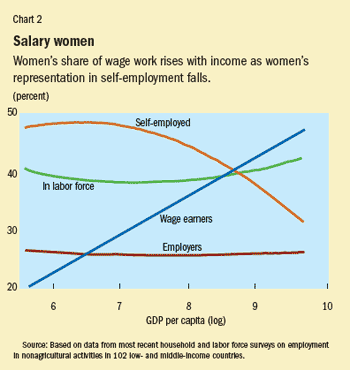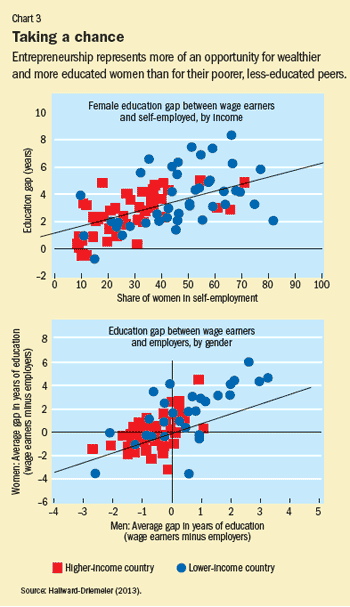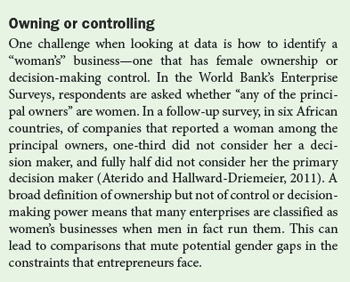Ready to Bloom?
Finance & Development, June 2013, Vol. 50, No. 2
Mark Blackden and Mary Hallward-Driemeier
Employment in high-return activities is the pathway to economic empowerment for African women

Tanzanian businesswoman Dina Bina has been running and promoting Dina Flowers Company Ltd. for over a decade. She emphasizes customer care: “You should go out of your way to do something extra.” It paid off for her when she was offered a contract to help do the landscaping at Dar es Salaam International Airport. When her husband, Mwita Bina, saw how the company was thriving, he left his own job to join Dina Flowers and is now its chief financial officer. “We went into the flower business because of Dina,” he says. “She noticed an opportunity, because there were hardly any florists in town.” Mwita’s salary provided the start-up capital for Dina Flowers. Of his wife’s success, Mwita says, “I suspect there are a lot of men who would be threatened. But I am not one of those. For us it’s worked well in that we really complement each other.”
As the story of Dina Flowers (Cutura, 2007) illustrates, women’s success in business depends on the convergence of many factors, including a market opportunity, adequate financing, entrepreneurial and technical skills, and networking. These matter for men’s businesses too, but evidence shows that women often face greater obstacles in accessing them. And, especially for women, family support can be critical. In fact in several countries, husbands can legally deny their wives permission to work, sign a contract, or even open a bank account.
Two recent World Bank studies focusing on women’s economic opportunities in sub-Saharan Africa examine where women and men work, how women’s businesses perform compared with men’s, and the economic and legal obstacles women must overcome if they are to expand their economic and entrepreneurial activity (Hallward-Driemeier and Hasan, 2013; Hallward-Driemeier, 2013).

These studies find that gender gaps in economic opportunity in the region stem less from whether or not women work than from differences in the types of activities women and men pursue. Women are much more likely to work in the informal sector, in smaller enterprises, and in traditional industries such as garment making and food preparation—all of which tend to pay lower returns. Expanding women’s economic empowerment is about enabling more women to operate in activities that offer higher returns. This requires addressing constraints on women’s access to assets, expanding women’s financial and managerial training, and involving more women in the policymaking environment.
Women in sub-Saharan Africa work. Few can afford not to. Nationally representative labor force and household survey data from over 100 low- and middle-income countries show that women’s labor force participation rates are higher in sub-Saharan Africa than in any other region (see Chart 1).

In sub-Saharan Africa, women are particularly active as entrepreneurs. However, they are disproportionately self-employed. Women make up 40 percent of the region’s nonagricultural labor force, but account for nearly 50 percent of the self-employed (see Chart 2)—the highest share in any region. By contrast, women represent only one-fourth of the region’s employers, a share that does not change much with a country’s level of development and is mirrored in all other regions except the Middle East and North Africa, where there are even fewer women employers, about 12 percent. In general, as a country’s income increases, women’s share in wage employment rises dramatically.
Education and opportunity
The extent to which entrepreneurship represents opportunity varies with a country’s level of development and an individual’s education. Dina and Mwita Bina in Tanzania are both well educated, which facilitated their success in the business world.
One way to look at this is to compare the levels of education between different categories of employment. In virtually all countries, wage earners have more years of education on average than those who are self-employed (see Chart 3, which shows the pattern for women—a similar pattern is observed for men). The gap in education between wage earners and the self-employed is greatest in low-income countries and where self-employment is higher, namely in sub-Saharan Africa. This suggests that women’s high level of self-employment in sub-Saharan Africa is less a reflection of strong opportunity in entrepreneurial activity than of lack of opportunity for wage employment.

In high-income countries, wage earners are generally less educated than employers (see Chart 3: most markers for rich countries are in the lower left quadrant), but in low-income countries the reverse is true (more markers in the upper right quadrant). Indeed, the education gap for female wage earners and employers is greater than for male wage earners and employers in low-income countries (blue circles above the 45-degree line). In low-income countries, few women work for wages, and those who do are relatively more educated than their male colleagues.
In low-income countries in sub-Saharan Africa, where men are three times more likely to be in wage employment than women, women’s opportunities are concentrated in entrepreneurship. So to understand women’s economic opportunities, it is useful to compare how women and men entrepreneurs perform, and how to expand the returns to this type of economic activity.

We find, on average, that women’s businesses are less productive than men’s, using “ownership” as the criterion for identifying “women’s businesses” (see box). But once the sector of the enterprise, its formality, its size, and its capital intensity are taken into account, the gap disappears.
If a woman’s enterprise is defined more narrowly as one in which a woman is the decision maker, there are wider performance gaps in productivity and profitability. But the effects of sector, formality, and size overwhelm gender differences. Where gender differences are significant is in determining where men and women work in the first place.
Sorting economic streams
The greater concentration of women in smaller firms, in the informal sector, and in traditional women’s industries shapes women’s opportunities and potential much more than any differences based on gender. Better understanding of why these gender-distinct patterns of economic participation persist is essential to building economic opportunity for all in Africa.
More opportunity for women is not about increasing their economic participation itself, but rather shifting the type of activities they undertake. To expand women’s economic empowerment in sub-Saharan Africa, more women must move into higher-return activities.
The absence of significant gender-based barriers once businesses are operating does not mean that there are no gender-based obstacles to entrepreneurship. There is evidence that barriers to entry into entrepreneurship present greater obstacles for women than for men. Measures that improve access to markets and to finance for smaller firms and those in the informal sector would disproportionately help women entrepreneurs. The spread of information and communications technology, and of mobile phones in particular, is one such step: this technology provides information on prices, easier access to customers and suppliers, and access to mobile banking. However, women’s access lags men’s even in this area (GSMA, 2010). Other steps to reduce barriers include streamlining regulatory requirements (business registration, licensing), curbing corruption, and facilitating the formalization of small firms. But these steps will help women only if the legal protections afforded by the formal sector apply in equal measure to men’s and women’s businesses, which is by no means always the case.
Equal rights
Equal access to and control of assets are critical. Without property rights or the ability to retain the returns of one’s efforts, there is little ability—or incentive—to invest and work hard. Yet it is precisely in the areas of property rights and legal capacity that the law explicitly differentiates between women and men in many countries.
We analyzed provisions in constitutions, international conventions, and statutes that affect women’s property rights and legal capacity in sub-Saharan African countries to map out where, and in which areas of the law, women have the same economic rights as men. We were surprised to find that gender gaps in economic rights are not correlated with a country’s level of income. That means a country will not automatically become more equal as it grows; closing gender gaps requires deliberate actions.
If gender gaps in economic rights persist, they affect women’s opportunities, even as incomes rise. In richer countries, more women move from self-employment to wage work, but not necessarily to becoming an employer. The share of women who are employers does not vary with income. However, regardless of income, the stronger women’s economic rights, the greater the share of female employers. Controlling for income, women in countries with unequal property rights and legal capacity (for example, where a husband’s permission is needed to work or enter into contracts or where customary law governs marital property and inheritance and is constitutionally exempt from principles of nondiscrimination) were one-third less likely to be employers (Hallward-Driemeier and Hasan, 2013). Addressing formal economic rights helps women rise and run larger companies.
The Women’s Legal and Economic Empowerment Database for Africa (Hallward-Driemeier and others, 2013) documents where these gaps are—not only across countries, but also across sources of law and types of statutes. Business regulations rarely have gender-differentiated provisions. But these laws and regulations all presuppose that the parties can enter into contracts, move freely, and own property or control assets in their own name. It is family, inheritance, and land laws that define rights regarding legal capacity and property ownership. And it is precisely in these areas of the law that gender differences, including outright discrimination, are most apparent (see Hallward-Driemeier and others, 2013).
Dina Bina was fortunate that she did not need her husband’s permission to set up her business and was able to obtain start-up capital through her husband. In countries where women do not have the same inheritance and land ownership rights as men, they may lack collateral for bank loans. Strengthening property rights thus improves women’s access to finance, as do property registries that include movable property; credit registries that capture women’s credit and repayment histories, especially in the area of microfinance; building human capital and financial literacy; and developing financial products and mechanisms that specifically address women’s needs and constraints.
Gender gaps in years of schooling have been declining over time, though they remain a concern in many low-income countries. But beyond general education, specific management skills, including financial literacy and the ability to set and monitor performance goals, are important—for companies and employees. Women are less likely to learn these critical skills through formal programs or informal family networks (Aterido and Hallward-Driemeier, 2013). But they certainly benefit from such skills training. In the surveys we conducted, women who scored as well as men on tests of management skills ran businesses that were as successful as men’s.
It is critical for women to be active in business climate reform, not only because they themselves are strongly engaged as entrepreneurs, wage workers, and employers, but also because the obstacles and constraints they face—and their perspective—often are quite different from those of their male counterparts. Women tend to have different experiences of legal, regulatory, and administrative barriers to economic participation. At the same time, they are largely excluded from policymaking in the private sector and from dialogue between the public and private sectors. Consequently, women’s presence in the private sector, as important economic actors in their own right, is not matched by their representation in private policy- and decision-making institutions. This exclusion is costly, not just to individual women and their businesses, but to the economy as a whole.
Women’s greater engagement in business climate reforms can be supported in three key ways.
First, advocacy for policy reforms needs to be grounded in solid, country-focused analysis of opportunities and constraints in the business environment and, specifically, of how these differ for men and women. The importance of evidence-based research and analysis as the foundation for effective lobbying for policy change cannot be overstated. Some policymakers and practitioners still have to be persuaded that addressing women’s issues in business is important in its own right and that doing so can have valuable payoffs for the business sector and the economy as a whole.
Second, women’s involvement in business associations needs to be encouraged and strengthened. Such associations provide an important platform for advocacy, but many women are not involved in mainstream dialogue and advocacy and often lack the capacity and experience to undertake this work effectively. Women’s business associations are at the intersection of three key mechanisms for improving women’s business opportunities: providing and sharing information and knowledge, particularly about economic rights; strengthening advocacy for reforms by educating and influencing decision makers; and building partnerships among key stakeholders to share experiences and strategies and to amplify the voices of women in policymaking. Strengthening women’s business associations is therefore a critical task, so that they can help their members improve their business practices and performance and also play a more active role in policy dialogue and lobbying for reforms.
Third, strengthening dialogue between the public and the private sectors in projects to improve the business environment is one of the best ways to ensure that policy reforms reflect the priorities of all stakeholders and will be implemented. To date, however, women’s businesses and their associations have been largely absent from such dialogue. Gender inclusion can help ensure that women’s voices are heard as investment reform priorities are developed and implemented.
Dina Bina’s resume includes membership in various organizations, including the Tanzania Women’s Chamber of Commerce, and she attributes part of her success to networking. “It is good to be part of an association, and I am encouraging young women to do it,” she says. Her advice is an important first step: involving women in the creation of a business environment that is favorable to all, men and women. ■
Mark Blackden is an independent consultant working on gender issues in development, and Mary Hallward-Driemeier is a Lead Economist in the office of the World Bank Chief Economist.
References
Aterido, Reyes, and Mary Hallward-Driemeier, 2011, “Whose Business Is It Anyway?” Small Business Economics, Vol. 37, No. 4, pp. 443–64.
Cutura, Jozefina, 2007, Voices of Women Entrepreneurs in Tanzania (Washington: International Finance Corporation).
GSMA Development Fund, Cherie Blair Foundation for Women, and Vital Wave Consulting, 2010, Women and Mobile: A Global Opportunity (London: GSMA).
Hallward-Driemeier, Mary, 2013, Enterprising Women: Expanding Opportunities in Africa (Washington: Agence Française de Développement and World Bank).
———, and Tazeen Hasan, 2013, Empowering Women: Legal Rights and Economic Opportunities in Africa (Washington: Agence Française de Développement and World Bank).
———, Jane Kamangu, Emilia Lobti, and Mark Blackden, 2013, Women’s Legal and Economic Empowerment Database for Africa (Washington: World Bank).
Simavi, Sevi, Clare Manuel, and Mark Blackden, 2010, Gender Dimensions of Investment Climate Reform: A Guide for Policy Makers and Practitioners (Washington: World Bank).


